Individual growth in areas other than academics is equally important. Learning also takes place outside the classroom in the Sports field,not required the Arts & Crafts Studios, the Dance & Music arena and other activity zones. The School has a well equipped co-curricular department that facilitates students in exploring their creative interests and develop a range of Life-skills. The Fine Arts (Art, Crafts, Music, Dance & Drama) build cultural awareness and help sharpen sensibilities. Weekly theme based assembly etc presentations by every house and many other cultural programmes in an academic year ensure participation by every student.
The school has a house system comprising of four houses. Students are assigned to one of the four houses monitored by a house mother/master and other teacher members.
School also has a dynamic student council. It consists of House Captains, Prefects, Sports Captains, Head Boy and Head Girl supported by an Executive Committee.
Council members are inducted every year through a formal Investiture Ceremony. The council is responsible for helping the school administration in smooth functioning of the school. The objective behind the student council is to inculcate leadership qualities and team spirit through real time practice.
Inter House Competitions in debate, elocution, creative writing, painting, mime, just-a-minute, one-act play, etc. are routine activities at the school. To showcase the results of these activity classes, regular exhibitions/presentations are held throughout the year. Professional visiting faculties facilitate a high standard of performance. Students get to learn what they choose. Opportunities to presents their talents are plenty.
IT'S NOT JUST ABOUT INDIVIDUAL SKILL & TALENT OR INDIVIDUAL VICTORY. . .
but about participation; about being a part of many, be it large or small group activities especially festivities, annual celebration or outdoor adventure camps.
All major festivals are celebrated in school to give students an insight into the richness of our culture and significance of each festival. This also provides them with sufficient chances to perform on stage.
Clay Modelling: The kids are instinctively motivated to explore clay’s inviting soft and responsive sensory qualities. Experimenting with clay engages and fosters intelligence, imagination and creativity and also gives the children the confidence to communicate their vision. Once children learn to express their visions in clay, they can become empowered in ways that go far beyond the art room.

Art: Art helps children sharpen their visual qualities and turn their ideas and feelings into reality. Each child is different and so is their interpretation of things. We encourage children to use drawing and painting as a means of thinking. Arts and Crafts activities will stimulate child’s imagination & creativity, helping with physical & mental development.

Embroidery: The art of hand embroidery improves concentration and motor skills in children and that is why we introduce this historical art-form right from the early standards. It is a treat watching the jumping tiny tots use all their will power in putting the thread in the needle hole and patiently working for months to complete their beautiful design.

Craft: Craft teaches the students correct usage of tools and materials. Making your wild imagination a truth by using conventional and unconventional materials is what craft at JGIS is. From brand new paper to construction waste, our children use everything to create what they envision.

Do it Yourself: Through Do it Yourself activities, the students learn to practice and perform manual work individually and collectively. They are also acquainted with the world of work and services to the community. Children enthusiastically participate in these productive activities and develop an attitude of team work and socially desirable values like self-reliance, dignity of labour, tolerance, co-operation, sympathy and helpfulness. Children are learning Carpentry, Plumbing, Electric work , Sewing, Ironing, Shoe polishing.

Calligraphy: The art of beautiful writing. Improves concentration in students and helps them to be more artistic and creative.

Theatre Club: To provide a medium to the JGIS students to nurture their skills and enable them to communicate their internal and external expression through the mode of theatre. Students learn the basics of stagecraft, the importance of hard work, creativity & imaginative play, listening and observation skills and self-confidence.

Electronics Club: Students work on a variety of projects and challenges such as bridge building, cardboard boat designs and electronic circuits. Basic understanding of how electricity works and how to build simple and complex circuits may give students a competitive edge for their future.

Computer Club: In the technology driven times, it is school’s unvarying enterprise to amalgamate technology in the school’s curriculum to make learning an uplifting experience. Giving hands on experience into the real world of computers, where they learn and polish their skills in web designing and photo editing tools. This enhances students’ artistic talents before the computer screen.

Cookery: Children learn about food safety and meal planning skills that help them learn about nutrition and healthy choices in a fun interactive way.

Dance: Dance is powerfully for developing many of the attributes of a growing child. Dance is a natural method for learning basic form of cultural expression.

Music: Playing music lights up your brain like no other activity. When you are playing music, you are using so many different brain areas, all at the same time.

Aerobics: Aerobics actually means ‘to live in air’. The aerobic exercises for children not only make them fit, but also instill a sense of confidence in them. It leads to the creation of a new form of exercise where all elements of a healthy body – muscular strength, flexibility or cardio-vascular fitness were enhanced. Aerobics consists of some important elements which make the learner physically fit and competent. These elements include jumps and leaps, flexibility, kicks, balance, dynamic and static strength.

Robotics: Robotics can boost students' problem-solving skills, teamwork, creativity and technical knowledge in an engaging, collaborative way. Robotics included are a number of different basic kits and components that can later be built on and expanded in order to create more complex robotics projects. It gives an opportunity to hone their skills in science, technology, engineering & mathematics through stem technology.

Sports Activities...
Sports are given a prominent place in the Curriculum. Children who are physically active and fit tend to perform better in all spheres of life. There is a huge playground for various outdoor sports and infrastructure for various indoor games. Students are trained in various sports like football, Atheletics,non-quipmental, badminton, chess, karate, basketball, skating, table tennis, yoga, roller skating, cricket. Professional coaches are engaged to provide ample training and practice to students. Massive playground is a significant feature of school campus.
The school’s “Sports Domain” is equipped with latest sports gears and gadgets. Students are trained and encouraged to participate in aforementioned sport events in house, inter school, zonal, state and national level as it is realized that physical fitness is a pre requisite for a sound and well balanced mind. Annual Sports Meet of the school ensures hearty participation of students right from class I to XII. The Football, Table Tennis, JG-Cup Tournament have won accolades which is unparalleled. Over the years it is proved to be one of the mega events of the state.
Physical Education classes provide student with an opportunity to build confidence and play alongside their peers. Inter house and Inter School matches help build team spirit and competitiveness.
Athletics: The sport of athletics is a collection of sporting events that involve competitive running, jumping, throwing, and walking. The most common types of athletics competitions are track and field, road running, cross country running, and race walking.
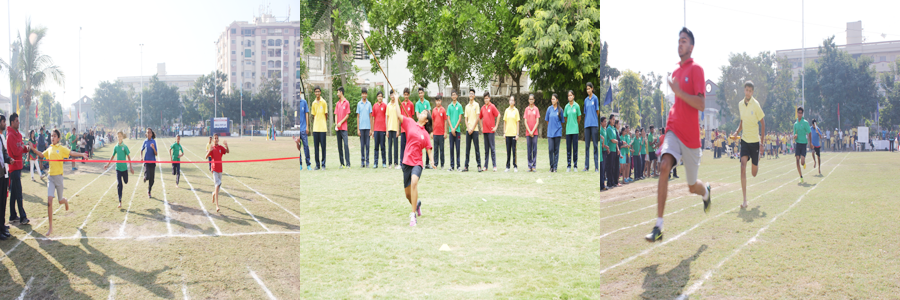
Basketball: Basketball is a sport played by two teams of five players on a rectangular court. The objective is to shoot a ball through a hoop 18 inches (46 cm) in diameter and 10 feet (3.048 m) high mounted to a backboard at each end.
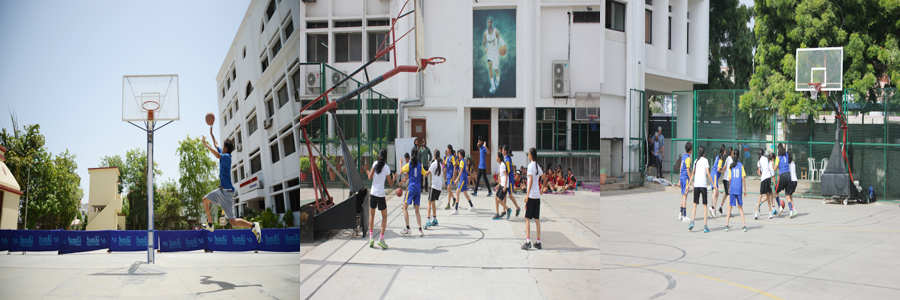
Badminton: Badminton is a racquet sport played using racquets to hit a shuttlecock across a net. Although it may be played with larger teams, the most common forms of the game are "singles" (with one player per side) and "doubles" (with two players per side). Badminton is often played as a casual outdoor activity in a yard formal games are played on a rectangular indoor court. Points are scored by striking the shuttlecock with the racquet and landing it within the opposing side's half of the court.
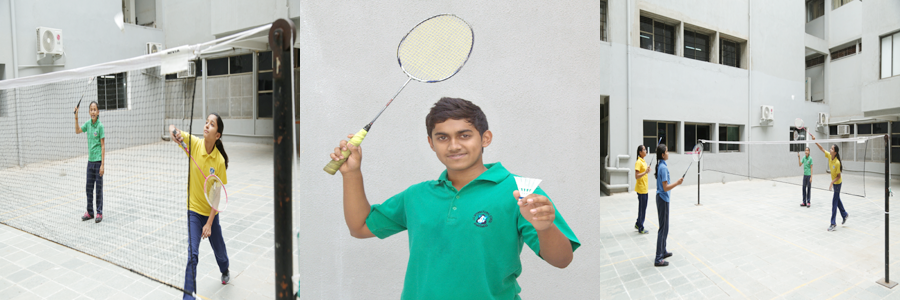
Chess: Chess is a two-player strategy board game played on a chessboard, a checkered game board with 64 squares arranged in an eight-by-eight grid. Chess is played by millions of people worldwide, both amateurs and professionals. Each player begins the game with 16 pieces: one king, one queen, two rooks, two knights, two bishops, and eight pawns. Each of the six piece types moves differently. The most powerful piece is the queen and the least powerful piece is the pawn. The objective is to 'checkmate' the opponent's king by placing it under an inescapable threat of capture. To this end, a player's pieces are used to attack and capture the opponent's pieces, while supporting their own. In addition to checkmate, the game can be won by voluntary resignation by the opponent, which typically occurs when too much material is lost, or if checkmate appears unavoidable. A game may also result in a draw in several ways.
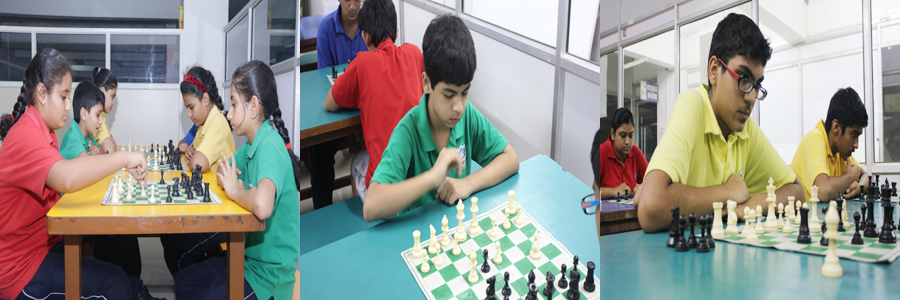
Cricket: Cricket coaching will allow students to enjoy personal attention with one of our qualified coaches. Our coaches will cover specific points of the game with an aim to focus on the more detailed aspects. Batting, bowling, fielding as well as mental aspects of the game are covered in depth.
- Batting: Front/back foot, error correction, planning, strategy, positive thinking and focus exercises.
- Bowling: Action, variation, planning, strategy, positive thinking and focus exercises.
- Fielding and Wicket-Keeping: Catching, ground fielding techniques, anticipation, feet movement & role definition
- Report: Feedback analysis every term.
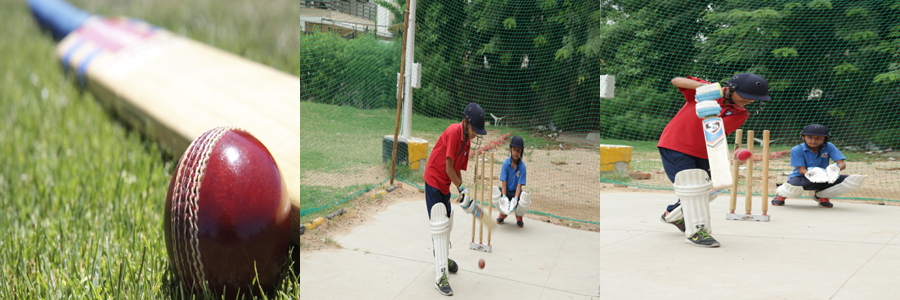
Karate: A system of self-development using kicks and punches. Its quick, sharp actions involve snapping movements of the joints, which means that kids need to warm up carefully. Sports like Karate are a fun way for both boys and girls to achieve fitness and focus. The martial arts actually help teach self-discipline and socialization skills. A typical hour-long class begins and ends with a bow to the teacher, or master. After a warm-up, students practice the art's particular skills, which may include kicks, punches and blocks. Each requires concentration and strict attention.
Progress is often marked by the belt system, which takes the beginner from a white belt through a variety of colors until black. Testing for each new level, generally every three months, is a good exercise in setting and achieving goals.
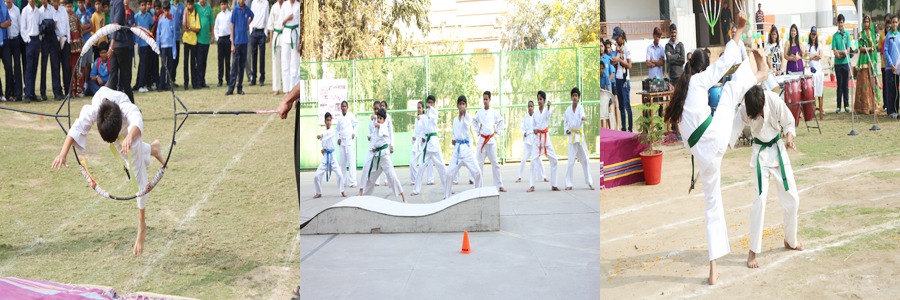
Non-Equipmental: The non-equipmental is to play games with simple rules that don't need any equipment. Good weather draws everyone outdoors, regardless of the season. Younger children naturally adventure outside for playtime, while older children usually gravitate toward more focused activities including team and individual sports. No matter their age, it’s important for children to use their imaginations and explore their interests when they spend time outside. It’s also a good idea for them to make the most of their time outside by getting valuable exercise.

Skating: Skating boost youth fitness and self-esteem, and emphasize the development of life-long physical activities.

Table Tennis: A comprehensive Table Tennis in Schools Program to facilitate the growth of students. The Table Tennis in Schools Program offers a range of opportunities to increase the number of young people experiencing and playing quality Table Tennis in Schools.

